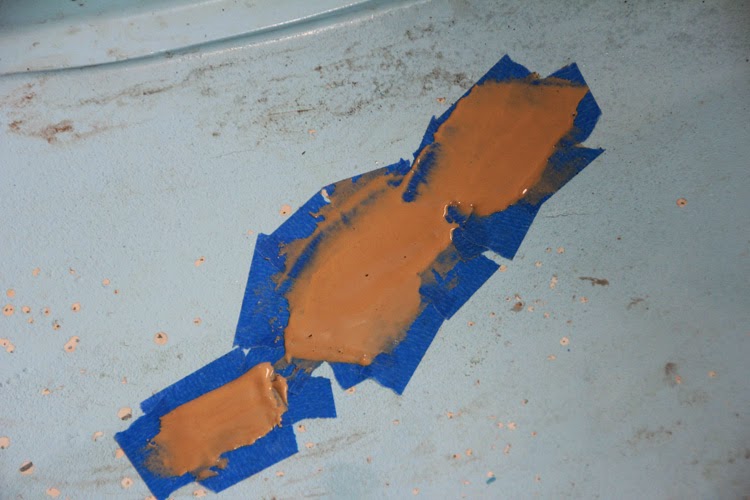When making small fairing repairs, there is a lot to recommend taking a couple minutes to tape off the area with masking tape. The amount of sanding needed, the most disgusting and time consuming part of any boat repair, is reduced substantially. Once the fairing putty is created, use a flexible polyethylene squeegee, or for more precise control, a fairing squeegee with a metal blade, to spread the putty over the area being filled or faired. The more precise your work now, the less you’ll have to sand, or even refill, later.
For those without a lot of boat repair experience, a word about mixing resins is important. The two most frequent failures in mixing resins is handling small quantities, and inadequate mixing. The importance of mixing small quantities is that minor differences in measuring parts A and B will greatly, and adversely, affect the mixing ratios. When I speak of small quantities, I’m talking about part A quantities of two tablespoons. The risk is in not getting enough catalyst to properly harden the resins. As measured quantities increase for more substantial repairs, ratios are easier to handle with less error.
Comparing the two pictures, you can immediately see how much sanding
area has been eliminated. All the overrun above has been eliminated, making
the job neater and easier to sand.
The best description I’ve seen about the importance of mixing resins went like this: Mixing is always important, but with polyester resins, the molecules will seek each other out to link and create a bond. The epoxy resin molecules of parts A & B, however, have to be mixed well enough that the molecules are immediately adjacent to each other to link. Thus, inadequate mixing counts as the number one cause of resins not hardening properly. Small quantities, in a tuna fish can, should be mixed for 3 minutes. Larger amounts should be mixed for 5 minutes, even with a power stirrer.
The foredeck after gelcoat repair and painting.
To create a fairing putty, once the epoxy is properly mixed, add the thickening agent slowly as it is mixed in until you get the consistency that you like. Experience will tell what you find most workable. You want it thick enough that it won’t sag on sloping or vertical surfaces. I look for something half way between peanut butter and wood putty. Getting it too thick wastes materials, weakens the putty, and makes smooth, even spreading more difficult. Also remember that the resin will warm up as it’s chemical process begins, so putties will always get slightly thinner, making sags more likely. Always check back a few times on previous work to making sure it is staying where you want it until it begins to harden.
Its proper name is a boom saddle, but on such a small boat it looks
more like a 3/4-in. plywood donut. The damage to the foredeck was
from the jaws of the boom grinding and banging on the foredeck.
It's a lot easier to sand and paint the saddle than doing fiberglass and
gelcoat repair to the deck. Here, the jaws come onto the basically
sacrificial boom saddle instead.
There are specialized thixotropic agents, which I used to use a lot when doing polyester work. It was a two step mixing process using both thixotropic powder and microspheres. With epoxy, I find it easier to go straight to microspheres. I use West System 410 Microlight Fairing Filler. It is great stuff to work with, and it cuts sanding time substantially. There is one caveat. The microspheres are a thermoplastic-based filler, so caution may be needed in using such a filler under dark painted surfaces like dark blue or black, which will be heated to extreme temperatures by the sun.
P.S. - I would think Cape Dory had some way of dealing with the boom saddle issue when the boat was first built. Cape Dory has an owner forum, and I'm going to check with other owners to see if there are other ideas, but this saddle seems the best option thus far, but I'm not done with the matter. Another way would be to make a 1/4-inch fiberglass sheet and cut out a boom saddle and just leave it unpainted. We'll see.




No comments:
Post a Comment